Costa Rica is a beautiful country that has attracted the attention of visitors, ecotourists and backpackers in recent years, mainly because of the wide variety of tourist destinations available throughout the year, all rich in wildlife and incredible panoramic views. Whether sleeping in a tree house, luxury hotel, country house, or camping in the mountains, Costa Rica is a destination for the adventurous traveler.
You can zip-line through the jungle, go rafting in fierce waters, or climb a volcano. Costa Rica is a destination that has options for all tastes. The impressive flora and fauna that accompany it have a real attraction for the tourist, even for the most eccentric and experienced.
Here we present the 7 most requested tourist places for this year:
Monteverde
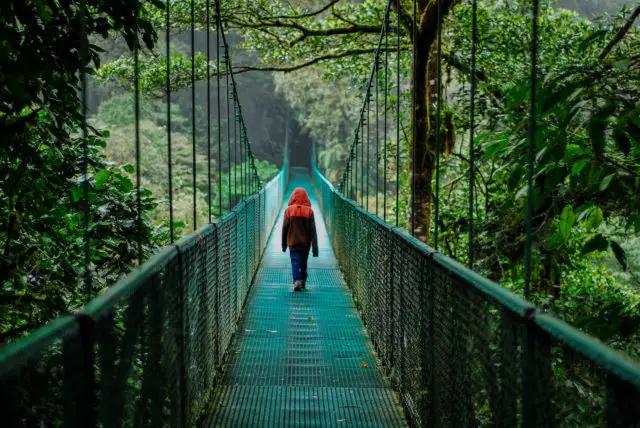
The Monteverde Cloud Forest Reserve is located 5 kilometers east of downtown Santa Elena. This Biological Reserve belongs to the Tropical Scientific Center, founded in 1962, a Costa Rican non-governmental organization. Located in the Arenal – Monteverde Protective Zone, which belongs to the Arenal-Tilarán Conservation Area.
The objectives of the Conservation Area are to preserve the valuable biodiversity of this region, protect the many springs and create optimal conditions for nature, protecting the natural reserves of Costa Rica.
The reserve is very well developed and provides a very good view of the rainforest vegetation. Access to the Monteverde reserve is limited to a maximum of 200 people at the same time. Monteverde is famous for its adventure attractions, from bird watching, horseback riding, to canopy flying over the cloud forest up to a distance of 1 km.
Due to the COVID-19 measures currently implemented, the use of face masks is mandatory throughout the tour, as well as abiding by the capacity measures and booking in advance.
Manuel Antonio National Park
Manuel Antonio National Park on the Pacific coast of Costa Rica is one of the most visited spots in the country on almost every trip. The photo of the two beaches: Playa Manuel Antonio and Playa Espadilla is perhaps one of the most used photos of Costa Rica.The city of the same name is probably one of the most important tourist centers today, due to the relatively short distance from San José.
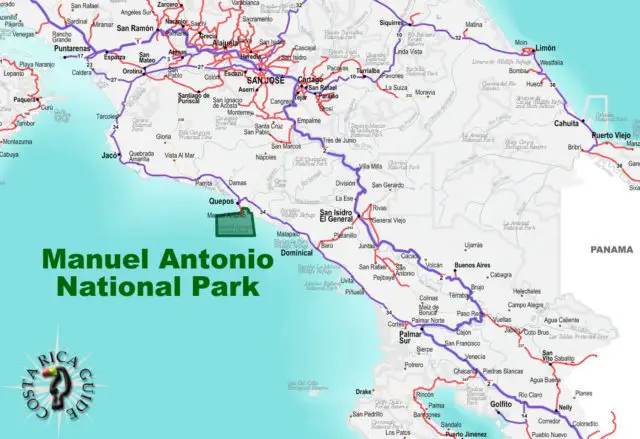
The variety of tours and activities in Manuel Antonio is enormous, highlighting in addition to its beaches, waterfalls and horseback riding in Arroyo Quebrada, at the foot of Cerro Nara. The largest waterfall is a good photo opportunity, and the smallest is a natural pool of revitalizing water that you can plunge into.
To enter the park, you must buy tickets in advance on the website www.sinac.go.cr to ensure that you can comply with the protocols for distancing and allowed capacity. In addition, it is remembered that you must visit the park respecting the use of masks and undergo temperature control at the entrance
Tamarindo Beach
Tamarindo Beach and the town are part of the Las Baulas de Guanacaste National Marine Park. A very attractive tourist site for turtle watchers and nature lovers.In the north, it borders Playa Grande across the mouth of the Matapalo River.

This locality is one of the most important nesting sites for leather turtles on the entire Pacific coast. The beach has also been very popular for its white sand, its waves and its crystal clear waters. It constantly receives a large number of emigrants from Europe and North America, making it grow as one of the most visited surfing areas in Costa Rica.
Tenorio Volcano National Park: Rio Celeste
The turquoise waterfall of the Celeste River is another magical and natural point in Costa Rica, which you must include in your trip planning. This river is known for its turquoise blue color. If you are a fan of trails and hiking (and getting a little dirty) in this national park, you will have the adventure you were looking for.
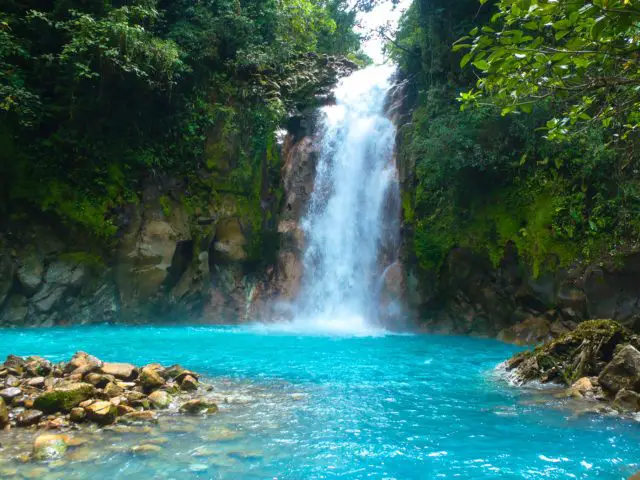
Right at the beginning of the hike, you will reach the dense rainforest, where not only toucans live but also some snakes and jaguars. After about an hour of walking, after the stairs, you reach the waterfall. It falls about 30 meters deep and is considered one of the most beautiful places in the world.
If you want to continue to the source of the Rio Celeste, simply follow the internal signs. Strong odors come from volcanic gases rising from the ground. Even in water, bubbles form through gases (bubbles).
Finally on the last trail, you will find the source, in which the Río Ácido and the Río Buenavista flow together. As both rivers have different pH values, a chemical reaction occurs turning the water blue when reacting with sunlight.
As in the case of other national parks, you must have the entrance ticket purchased on the SINAC website in advance and respect the measures and times indicated there.
Poas Volcano
At an altitude of 2,708 meters rises the imposing Poás volcano. The famous volcano best known for its two visually beautiful contrasting crater lakes.The main crater, which is circular in shape, measures about 1,320 m, and is 320 m deep. Cone Von Frantzius which is located about 900 meters north of the active crater. And the Botos blue lagoon (currently closed), an old crater occupied by a cold lagoon 400 m in diameter and 14 m deep.
The Poás Volcano National Park is open from 8:00 a.m. until 4:00 p.m. every day, including holidays. Due to its volcanic activity the park may be closedunexpectedly at any time and maintain controlled capacities. To enter, the ticket must be previously purchased on the SINAC website.
Arenal Volcano National Park
The Arenal Volcano National Park was founded in 1991. It covers an area of 5208 hectares, including not only the volcano, but also Lake Arenal and the northern sector of the Sierra de Tilarán. It is home to many endangered species of animals and plants, such as jaguars, sloths, tapirs, and other animals.
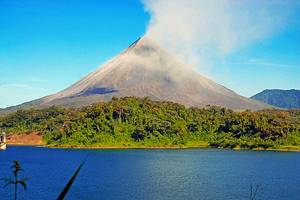
There are several hiking trails, where you can observe the diverse nature of the rain forest. You can also appreciate the immensity of the Volcano, which looks out at 1670 meters high, when you reach the lava field (Sendero Coladas). Where chilled rocks from ancient eruptions (1992) clump together in strange shapes.
This park is open every day from 8:00 a.m. at 4:00 p.m. It is required to buy the ticket in advance to enter, since there is a controlled capacity as a measure against COVID-19.
Marino Ballena National Park
About 120 kilometers south of San José, in the province of Puntarenas, the Marino Ballena National Park has a privileged location on the Pacific coast. It was the first National Marine Park to be established in Costa Rica in 1989. Although the land area is relatively small, only 170 hectares, this does not minimize the main underwater attractions of Marino Ballena.
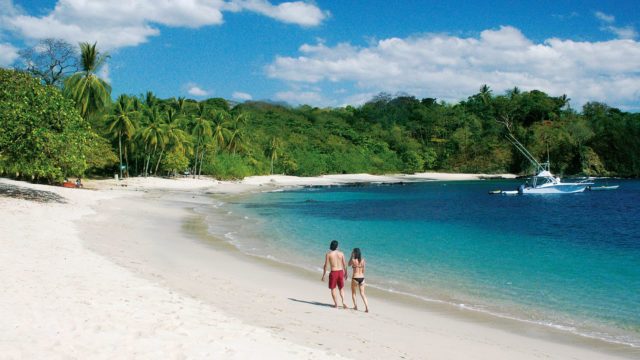
Among the marine creatures that can be observed are sea elephants, dolphins, humpback whales, coral reefs, reptiles and a large number of other creatures, as well as many species of birds. These include frigates, ibis, or pelicans. Most of them nest on the coast of Isla Ballena. Unlike the land area, the water surface of the Marino Ballena National Park covers almost 5,400 hectares.
In addition to this island, the Marino Ballena National Park is home to the Tres Hermanas, as well as the small island of Punta Uvita that is worth visiting.Now that you know the most popular destinations in Costa Rica, we recommend you review the best activities in the area, be it bird watching in Monteverde, or surfing on the beaches of Tamarindo, the multiple tours to know the flora and fauna of the different habitats, boat trips, kayak rental, canopy to enjoy the tropical forests from above and more. Remember that if you need a car to get around on these wonderful trips, we have offices throughout the country.

